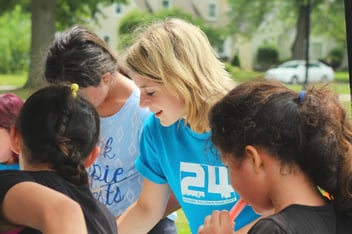Free Volunteer Program Planning worksheet
Every volunteer program has an overall mission to improve and empower its respective communities. And part of the secret to ensuring you're always moving towards your mission is to set strategic goals to guide your path. Without clear goals, your program lacks a roadmap to achieve the desired results.
Creating and communicating the criteria volunteers should follow may seem presumptuous or counterintuitive, considering they're sharing their experience and time for free. Nonetheless, sharing your vision and goals with your volunteers ensures everyone is working toward the same outcomes
If you're looking forward to integrating a successful volunteer program into your organization, driving more focus on volunteer goal setting can immensely benefit your program. This guide explains how to effectively set SMART goals for your volunteer program while providing volunteer goals examples.
What Are Volunteer Goals?
Volunteer goals are strategic objectives that an organization establishes to outline expected outcomes and guide volunteers' efforts. They provide a clearer path toward achieving success and realizing the vision of a program. Examples of volunteer goals include:
- Recruiting more volunteers
- Supporting more community development initiatives
- Increasing positive reviews for your program
Why Should Your Organization Set Volunteer Goals?
Setting clear goals has the following benefits for your volunteers.
- Giving Direction: Volunteer goal-setting is an effective strategy that provides direction and motivation to pursue specific milestones. Instead of hoping that your volunteers will figure out the direction of their positions, it's best to provide clear instructions through goal setting.
- Supporting Your Organization's Mission: By clearly stating your goals, current and potential volunteers can quickly determine whether they are a good fit for the organization's mission. This attracts volunteers with the skills you need to realize your vision and eliminate those with different priorities.
- Enriching Volunteer Recruitment: Individuals seeking to connect with an organization through volunteering often look for purpose. By describing goals to potential volunteer recruits, you allow them to visualize the kind of impact their efforts will have in your program. You're more likely to attract and retain top talent who align well with your organization's mission.
- Offering recognition opportunities: Volunteers thrive in recognition and appreciation. They will blossom in an organization that acknowledges their efforts and makes them feel an official part of the program. Setting goals provides measurable components that you can use to recognize and reward your volunteers.
Want this Volunteer Program Planning Worksheet delivered to your inbox?
How to Set Goals for Your Volunteer Program
Strategic goal setting for your volunteer program requires an in-depth evaluation of where your organization is currently and where you'd like it to be. Here are the best tips to get you there.
Begin by Evaluating Where You Are
Before creating your goals, it's critical to discuss with the relevant departmental members how your program is currently fairing in terms of volunteers, your mission, donors, etc. Reflect on your mission and ask if your ongoing initiatives align with your purpose.
- Which areas are succeeding, and which ones need improvement?
- Have the needs of your target community changed?
- How about your volunteers and partnerships?
- Are there shifts in their motivations?
- If so, are there changes you can make to meet them?
Figure Out Where You Want To Be
With a grip on your program's current status, it's time to decide the direction you want to take. Create a vision statement with a clear picture of your organization's future. This prevents mission creep while ensuring you're not swayed from your path.
Your team will likely have many suggestions, so you should set aside ample time to brainstorm ideas, aspirations, and expected outcomes. Below are some guiding questions to drive this session.
- What does your board makeup look like? Do your volunteers reflect the people you serve?
- What services will best support your beneficiaries in the future?
- What should your financial position look like to effectively deliver these services?
- What are your growth areas?
Answering these questions will supercharge and grow your volunteer program by ensuring you develop more strategic and obtainable goals.
Draft SMART Goals
It's super easy to jot down a goal like 'Find a corporate partner' or 'Increase the number of volunteers by 30%'. However, the SMART (specific, measurable, actionable, relevant, and time-based) framework is a more effective goal-setting methodology. It is a vital addition to any organization's plan and has proven effectiveness. Let's break it down.
- Make your goals specific for more effective planning. Numerical targets often provide more clarity. For instance, your goal may be to add 100 more volunteers before the first of next year.
- Ensure your goals are measurable so you can track your progress quantitatively. Select designated times to measure your progress, e.g., performing monthly or quarterly checks.
- Set goals that are achievable and actionable. Ensure your organization has the time, resources, and volunteers to meet your goals.
- Come up with goals that are relevant to your organization's mission and values.
- Ensure your goals are achievable within an agreed time frame. By establishing deadlines, your volunteers will avoid procrastination or loss of motivation. Don't forget to give yourself some leeway in case you hit a roadblock along the way.
Examples of SMART Goals for Volunteer Programs
Here is a list of six SMART goals for volunteer programs that can drive growth and impact.
- Hold a fundraising event: Every volunteer program needs funds to survive, and raising funds is among the most critical goals examples.
- Recruit more volunteers: Adding more volunteers can be a key goal for your organization based on your mission and objectives.
- Operate more sites: If your organization has one or more physical sites running successfully, you might consider adding more to increase your reach.
- Receive media coverage: Gaining media coverage can boost your credibility and increase your exposure to new audiences. It's an invaluable strategic goal that can get your message out there.
- Create corporate partnerships: If your volunteer program doesn't have partnerships with corporate businesses, it's time to consider how to form them. They can provide a new source of volunteers or become regular and major donors.
- Win awards: Winning volunteer program awards does not only reward your hard work. It also helps you gain the attention of high-value volunteers, media, policymakers, and donors, making it a valuable addition to your strategic goals.
Once you've set clear goals for your program, you can communicate them to your volunteers during weekly meetings or through digital communication channels like email and SMS.
FREE DOWNLOAD
Don't forget your Volunteer Program Planning Worksheet!
Bottom Line
Strategic volunteer goal setting is instrumental to the success of your program. It provides a clearer path toward achieving your organizational mission while ensuring volunteers stay focused and effective. The above tips and ideas will help you create SMART goals that will enable you to continuously deliver on your mission.





